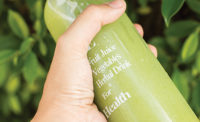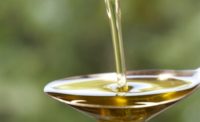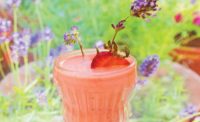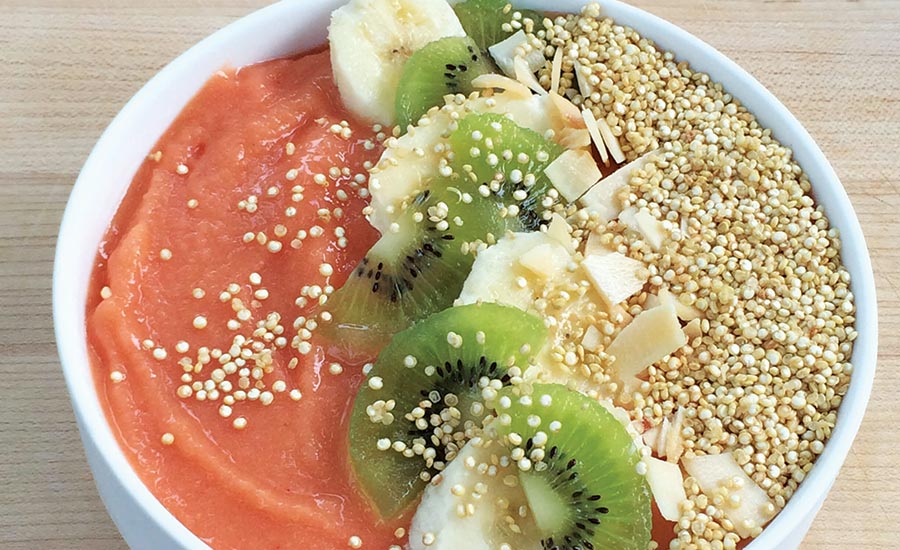Microorganisms in Food Product Development
Little living things are a big ingredient in food and beverage development

PHOTO COURTESY OF: Next Foods Inc./GoodBelly (www.goodbelly.com)

Bacillus coagulans spores are naturally protected from heat and acid, remaining dormant until they reach the lower g.i. tract where they provide the most benefit.
PHOTO COURTESY OF: Enjoy Life Natural Brands LLC. (www.enjoylifefoods.com)

All probiotic strains are not the same. Formulators should carefully evaluate efficacy and ensure the probiotic comes with gold-standard research support.
PHOTO COURTESY OF: DUPONT NUTRITION & HEALTH (WWW.DANISCO.COM)

Benefits from microorganisms are both direct (like probiotics) and indirect, such as using yeast as a source of nutraceutical ingredients—for example, prebiotic beta-glucans.
PHOTO COURTESY OF: WELLMUNE (WWW.WELLMUNE.COM)

Bakers' yeast and mushrooms are naturally rich sources of the ergosterol form of vitamin D, also called vitamin D2.
PHOTO COURTESY OF: LALLEMAND INC. (WWW.LALLEMAND.COM)





For several years now, pundits have been announcing the arrival of the “insects as food” revolution. Crickets and grasshoppers, mealworms, and even fruit fly larvae are being celebrated as concentrated, cheap, plentiful protein sources. Truth? Americans still are several years away from turning those little critters into mainstream food ingredients. Just look at the popularity plunge of cochineal colorant when its origin from beetles became widely publicized.
So, speaking of edible bugs, what about other little critters? Food and beverage processing is experiencing a monumental shift in the demand for foods that are made from, or are made with, or have added living microorganisms such as bacteria and yeast.
Also on the verge of trending big are products taking advantage of algae. The nucleus-containing (eukaryotic) members the algae family technically are not animals, they’re too complex to be classified as plants. Biologically, they’re often considered somewhere in-between. Nevertheless, they’ve proven to be the superior food ingredient source predicted in science fic-tion more than half a century ago. (See “Power Point: Manipulating Microalgae,” PF September 2016.)
An Ingredient Army
Certainly, the doors to perception of microbes as valuable ingredients were flung open by Jamie Lee Curtis touting The Dannon Co.’s Activia brand of yogurt. In addition to reassuring viewers that they were not the only ones with uncomfortable digestive issues, she put digestive health on the US map.
Probiotic bacteria that build gut health and immunity and provide other health benefits have been trending up rapidly, making multiple inroads into the daily diet. Yeasts that enhance flavor and are used to ferment beverages such as beer and kombucha are rich in specific health benefits from yeasts are coming to light in studies that show the microorganisms as being good for more than just making bread and beer.
Bacteria and yeast also occupy an intermediary position in that they are used to produce other functional ingredients. For example, new forms of stevia, specialized proteins, and other nutraceutical ingredients are now biologically produced by microorganisms in pristine indoor facilities, allowing for increased economy and purity.
Closed-system microalgae farms have been in place for a decade now, cranking out ingredients such as natural astaxanthin. Other controlled algae cultivation is providing high-protein flours and high-omega oils with high smoke points.
Why Go Small
Consumers are well aware of the positive aspects of members of what once was a shunned class perched on the lowest limb of the Tree of Life. A recent study revealed that more than nine in 10 consumers know what probiotics bacteria are and correlate them to health, especially digestive health, and well-being. Small yet mighty, microorganisms are asserting their dominance in the food chain.
According to most market research numbers, the demand for foods and beverages with probi-otics is encroaching on the $50 billion mark—if it hasn’t already ticked past that. Dozens of strains of these live cells are in use throughout the food and beverage industry. They’re incorporated into hundreds of products of all kinds. Nearly every month, a product hits supermarket shelves featuring some sort of active microbe, mostly from yeast or bacteria.
The rush of science that a couple of decades ago began to investigate the health value of probi-otics has revealed more than just a digestion benefit. Immune health, weight management, autoimmune disease management and mitigation, blood sugar control, dental health, and mental health all have shown the potential to be influenced by ingestible microorganisms.
Interest in all these potential connections between disease states (including obesity) and the health of the microfloral balance within is such that the National Institutes of Health recently recruited teams of scientists for its Human Microbiome Project. The goal is to build a “microbiological road map” of the entire human body.
From the Ground, Up

The notion of using beneficial yeast and bacteria to create tasty and healthful foods and beverages is ancient, but today’s agricultural scientists are now deploying microscopic armies to help make better ingredients from the ground, up. Literally. The bioscience company Locus Agricultural Solutions LLC is using fermentation to create customized microbial colonies that address specific challenges in growing safe and sustainable, ecologically friendly and better-for-you produce. Currently used primarily in citrus groves and tomato and potato fields, the near-site facilities are established to, according to the company, “address several challenges to agricultural productivity: Crop vitality and nutrition, soil microbial health, insect pest management, plant disease management, new tools for integrated management practices to better manage pest resistance to traditional chemical tools and provide for new tools to manage stressed water supplies.”
Dairy First
While all yogurt is made by using bacteria to ferment the milk, only the brands that have viable colony-forming units (CFU) of bacteria can actually claim to be probiotic. The terms “live” and “active” are not always synonymous with “probiotic.” In order to be probiotic, the active cultures need to meet three criteria: First, they need to survive the acidity of the stomach; second, they need to colonize the g.i. tract; and third, they should confer a benefit upon the host. Most bacteria don’t even pass the first hurdle, as the low pH level (high acid) of the digestive system is a powerful protection mechanism designed to kill microorganisms.
Through heavy marketing to active women, yogurt’s popularity has shifted markedly from being merely a breakfast option to being widely consumed as a healthy snack throughout the day. This popularity led to the emergence of drinkable forms of cultured milk (kefir) and the now ubiquitous Greek yogurt, with pioneer brands from companies such as Fage International SA and Chobani LLC.
Cultured dairy products also have benefited from the important role their high protein content plays in satiety. Coupled with the awareness of dairy as a source of much-needed calcium and vitamin D, dairy in this form has been able to thrive while liquid milk consumption has decreased. And yogurts are coming back to the breakfast table—or at least the breakfast hour—via the surge of the “side car” carrier of the solid ingredients. In fact, such “tip” yogurts, as they are known, are the fastest growing segment in the category.
Other expansions of probiotics in dairy include products such as ice cream and other frozen treats (for example, Nutricopia Inc.’s Brio) and “real” frozen yogurt that contains live and active cultures, such as Lifeway Foods Inc.’s frozen kefir. Flavored sour creams, farmer’s cheese, and quark have been trending up as well.
Recently, additions of savory flavors in cultured dairy have been working their way into the market, too. Companies such as Blue Hill Farm and Arla Foods USA (through its Skyr brand) have released yogurt flavored with sweet vegetables such as carrots, beets, and butternut squash. Noosa Yogurt LLC has spiced up some of its yogurts with jalapeño and habanero pep-pers. Yet, these still rely on sweetness to bridge the savory components.
Salty yogurt dressings have a long history in the Near and Middle East, as well as parts of South Asia. It has yet to be seen how sriracha and other exotic flavors will catch on in items destined for the US dairy case. Undoubtedly, there will be more creative developments that make this nutritious dairy food fit in with other eating occasions.
Horizontal Growth
As consumer interest in foods and beverages made more healthful through hosting microorganisms has expanded, the drive for probiotics that could segue from dairy into new applications have brought ingredient technologists and microbiologists together.
Next Foods Inc. was one of the first companies to see the opportunity to take a proven strain of probiotic bacteria and use it commercially in a non-traditional product: juice. Through exclusive licensing arrangements with a Scandinavian biotech pioneer, the company utilizes a unique technique to ensure the cultures in its GoodBelly product lines stay alive through a chilled shelflife of nearly three months.
Further, the probiotic bacteria in GoodBelly’s juices, shots, infused beverages, bars, and shakes are able to survive passage through the upper g.i. tract. This allows them to form colonies in the lower g.i. tract, the locus for the majority of healthy actions performed by the beneficial bugs.
Spore-forming bacteria, such as Bacillus coagulans, have proven to be a highly effective alternative to the live and active forms of bacteria. Such bacteria are protected by a natural heat- and acid-resistant capsule and remain dormant until the conditions in the digestive tract are optimal for them to crack open their shell and germinate.
This has allowed for food types that do not necessarily require fermentation to be vehicles for delivering healthy probiotics to consumers. The results of such biotechnology have yielded a flood of probiotic products ranging from dressings and spreads to chocolate and from cereal and granola to baked goods.
Probiotics’ Big Leap
Hundreds of products now demonstrate the versatility of the versatility brought to the table by the use of B. coagulans. Two examples come from Tribe 9 Foods LLC. The company has used the bacteria to bring the probiotic benefit to its Ona line of bars and its Yumbutter nut butter products. Smaller processors targeting the better-for-you market have been at the vanguard of bringing single-cell enhanced superfoods to market.
For some of these product makers, the move was a natural progression. “We started with the idea of making our Bakery Bites with veggies infused in them,” says Kay Allison, co-founder of Farm & Oven Snacks Inc. “But as we developed our recipes and became more aware of gut health as a burgeoning consumer trend, we combined the two important health benefits—increased vegetable consumption and probiotics—into our product. Our goal is to help consumers find the joy in healthy.”
After learning that some three quarters of people experience discomfort with digestion, Allison and her team decided to focus Farm & Oven on the task of delivering products that taste great and provide nearly half of the recommended daily serving of vegetables, plus high fiber and probiotics. “As veterans of the food industry, we know that a big key to our success is identifying and furthering the early trends that will grow significantly,” she adds.
Ensuring that their products contain 1 billion CFU’s of live probiotics per serving at the time of consumption led to the technical challenge of identifying a probiotic specifically created for high temperature applications. This is what led them to the use B. coagulans in their baked product.
Combining healthful benefits with probiotics was a natural step for Enjoy Life Natural Brands LLC (now a Mondelez International Inc. company), makers of allergen-free food products and baking mixes. The company incorporated B. coagulans probiotics into a line of baking mixes that include brownie mix, muffin mix, and others.
“We know our consumers well, and one of the issues that our consumers live with on a daily basis is digestive and immune issues,” explains Joel Warady, chief innovation officer for the company. “As we looked at opportunities to introduce additional probiotics into consumers’ daily diets, we saw baking mixes as an ideal opportunity to create great-tasting products that also had a functional purpose.”
The probiotic-enhanced baking mixes include ingredients such as plant-based proteins for added nutritional benefits, while remaining free from the “big 8” food allergens: wheat, dairy, peanuts, tree nuts, eggs, soy, fish, and shellfish. Since even shelf-stable probiotics can degrade under heat, utilizing them in a baking mix presented a unique challenge.
“Through very careful research and recipe development, we were able to find the proper pro-biotic that could withstand high temperatures,” says Warady. “We then added enough probiot-ics to result in a post-baked product that still is able to make an immune health claim. It is not as simple as just adding the probiotics into a mix.”
Jus Bar LLC, makers of the JUS By Julie brand of fruit juices and fruit and vegetable juice blends took a leap into hummus as a delivery system for probiotics. “We chose hummus as a vehicle because it has become a popular mainstream product that everyone can enjoy,” says Alan Maleh, director of product development. “Then we took it one step further by bringing additional nutritious functionality to the table.”
This is because as common a process as fermentation is, it still requires care. After all, fermentation is essentially a midway point between enhancement and spoilage. Yet, consumer interest in—and demand for—fermented foods and beverages has spiked upward in a surprisingly short time.
Fermentation Foods
Fermented products are not new, of course. It long been known that some of our favorite sta-ples—such as bread, wine, and beer—were created by using little critters called yeast. Techniques of fermentation were used thousands of years ago to preserve food before the advent of refrigeration. And what is yogurt—that probiotics poster child—but a type of fermented milk?
One of the first popularly fermented “modern” beverages—i.e., not beer or wine—was kombucha. Kombucha surprised many, first with first its resurgence and then its resilience as a category. This fermented “tea” uses a mix of yeast and bacteria and has caught on in certain circles despite its vinegar-like flavor.
After some consumer backlash resulting from recognition that the critters used in the fermenting process ended up dead from the high-acid environment, many manufacturers of the super-trendy beverage took to adding acid-tolerating probiotics to the finished “live” kombucha product. The success of the category has been such that at the end of 2016, beverage giant PepsiCo purchased one of the leading kombucha makers, KeVita Inc., for a sum estimated between $200 and $500 million.
A new kid on the fermentation block is Legacy III Partners Inc.’s Alive & Well organic olives, produced by a cooperative of olive farmers in Greece. Some of the farmers are growing the fruit on trees more than 1,000 years old. The group’s organic olives are grown, harvested, and fermentation-cured in Greece using naturally occurring live and active cultures.
“These are the cultures often referred to as ‘wild’ and include several strains of Lactobacillus, as well as yeasts and enzymes that are specific to that particular location,” says Greg Leonard, founding partner with Sotiris Kitralikis for Alive & Well Olives. “The specific blend of micro-organisms results in subtle differences in flavor and taste in the cured olives analogous to the terroir aspect of wine and cheese.”
The fermentation process used creates probiotic bacterial cultures similar to those found in yogurt, cheese, and sauerkraut. By dispensing with chemicals, synthetic probiotic cultures, or lye, the longer lacto-fermentation process yields organic lactobacillus cultures at levels of more than 55 million CFUs per jar.
The group preserves the cultures by packing the olives in a natural, nutrient-rich “mother brine” infused with the active cultures that proliferate during fermentation. The brine is even promoted by Alive & Well as “a perfect base for probiotic salad dressings or marinades.” While skipping the harsh processing and pasteurizing mandates that the product be kept refrigerated, the olives still are safe enough to last “a week or two at ambient temperatures,” according to Leonard.
Companies such as the food microbial technology research group Third Wave Bioactives LLC are teaming up with ingredient technologists to take yeast, probiotic bacteria, and fermentation in general to the next level in creating ingredients that enhance flavor and health. Functionality and clean-label concerns are foremost in their minds as they push the little critters we rely on for so much to bring even more to the table.
Originally appeared in the February, 2018 issue of Prepared Foods as Li'l Critters.
Looking for a reprint of this article?
From high-res PDFs to custom plaques, order your copy today!











